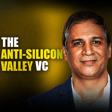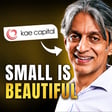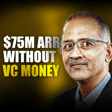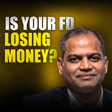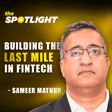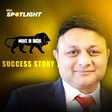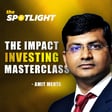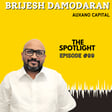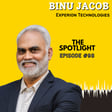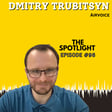Speaker
So, you know, saw that very upfront, saw how, you know, entrepreneurs are actually building business fundamentally. And this was the time, you know, when companies were actually going behind the real core of the business, solving for that core, right? When entrepreneurs were there who are helping always each other out. And I think that was very, very inspirational, right? The reason I took up entrepreneurship was because I was sitting in a particular board meeting, right? And there's a seasoned entrepreneur close to what, 20, 25 years of experience. And during the Reliance CVC days during my Reliance yeah Reliance days right you're in a board meeting and you suddenly feel the urge to you know give your two cents on a business that an entrepreneur has seen for so long right the entrepreneur just smiled at my suggestion very very kind of very kind of and that's the time it hurt you know saying that like you know it's so easy to be on the other side but you know the joy of being on the opposite side you know seeing it day in and day out right was a time when I decided that yes you know that is something that I really want to kind of you know do in my life and that's when you know started with my first entrepreneurial journey this was a company called Vishburg this is when we kind of you know were trying to build a social bucket list and then see how we can help people to achieve their wishes ran that for three and a half years out of a small flat this was India focused this was no this was actually global focused and I think that is something that we could have done better. This was a truly global platform. We had people from close to about 8,900 odd countries, you know, rediscovering us through Google and all of those things and just kind of, you know, sharing their bucket list with us and ran for about three, three and a half years. A lot of, lot of learnings, a lot of things on saying that, oh, this is how you should not be doing business, right? We, in fact, we had raised a small amount of capital at that point of time from India Quotient. Then, you know, and at that point of time, got an opportunity to work with the India Quotient team to start, you know, sort of a mentorship program. And that's when I kind of, you know, got, again, another exposure of, you know, meeting now the who's who of the, you know, startup phase. Back then, you know, knowing Anand Chen of CleverTap or knowing Dipinder Kowal of Zomato or Kunal Shah at Free Charge, right? Was like, you know, yeah, we are part of the same ecosystem. Obviously, a lot of respect for what they were building, but, you know, all of us were part of the same ecosystem. And being with them and, you know, exchanging thoughts with them was really, really something that helped in the next phase of the journey where Free Charge got acquired by Kunal at Free Charge. What I want to whisper, you shut that down? Yeah, we failed. We shut that down. We were acquired by Kunal, right? Kunal was, yeah. So Kunal was building the next growth phase at Free Charge. And one before we start Free Charge. What were the learnings from Visper? It seems to me like Visper could have succeeded if you had not raised money because it could have been a lifestyle business. Maybe you would have been 500,000 to 1 billion year kind of small product. I mean, there are lots of these micro SaaS is what they call them these days. It could have been a micro SaaS, maybe monetization through ad revenue, stuff like that, but not a VC-grade business for sure. And I'm saying this purely based on is there a time, is there monetization? What are your thoughts? Yeah, I think in today's day and age, I think Vishbhuk could have been a fairly big, interesting platform to have. I think back in the days, we were slightly early, right? Is that part of time? I don't see the time. What do what's the, you, I mean, what do you see? So think about it this way that, you know, people are kind of, this is all before you had the Instagrams of the world, right? Where you could actually go, you know, say that, okay, this is what I want to do, right? A bucket list of sort, right? I'm putting these bucket lists out there. It was, it also morphed into a sort of a social networking platform, right? Where people could come and discover each other's bucket list, right? I could add something that you would like to my bucket list, right? We also experimented with, you know, things like group buying, right? Where, say, 25 people in the same city could actually come together, right? And get a great discount on, say, an iPhone, right? Or could get a great discount on a Tata Nexon, right? I think back then it was a little early because we are all web first, right? It was not mobile native. Penetration was not there. People were always asking, people are already asking at that point of time, so why do we need to be on Facebook? This is of 2011 I'm talking about. India internet had not seen that, you know, that juncture. Yeah, the geo effect or the 4G effect, right? Where everyone had a smartphone in their hand, right? So I think time is definitely there, right? Because today also, right now while you're talking to me, right? There are three things that you wish for, three things that you want to buy, right? Two of them could be aspirational. One could be like, I need to buy it, right? And today with the disposable income that is available, I think it was a great way for people to discover what next, right? And that's exactly what we do on these social network platforms, right? Oh, someone bought something new, I want to do it, right? So I think a lot of scope for a product like Amazon has this for donkey's years now, right? The wishlist product, Yes. Right? Yes. I don't know whether they've, whether they call it that, whether they've scaled it or not, but I think a product outside of that would have definitely scaled and look at the amount of commerce that is happening. Look at the number of brands that are there today. Right? Great way to monetize it. Great way. And like, like you rightly said, right? A great way to run an ad network. I know exactly what you want. Google still knows and search intent, but a platform like this would actually know what exactly you want. I can exactly give the contextual feed for it. So I think it was a great one. I could have a discussion, but why would people come again and again? If this seems like a one-time thing, why would you come? Exactly. I think the needed hooks were not there. Right. That has been one of the biggest learnings. I think at that point of time, the thought process was on growth, engagement, and not on gratification. Right? I think if you can get some of those levers right, where there is growth, there is engagement, and obviously a way to gratify. Small, small things like I want to lose weight. I put it up as a wish. People come, start engaging with me. In the middle, some say a trainer comes and says, hey, you know what? Let me help you. Right. I'm able to put photographs. Right. Creates a feed of my, you know, wish list and what I've achieved. Right. It's my way of telling the world what all I've achieved in life. Right. I think that's something that will definitely bring people back. Okay. Do you think it was the right call to raise VC money? Yeah, because you didn't have money, right, at that point of time. And especially for me, someone like me who comes from the VC space, right, knows that there is money that can be raised out there. Right? So, you definitely want to put your previous learnings into practice and say, hey, you know what? Yes, we can raise money. But you raised before your PMF, right? We raised it during getting our PMF. So, it was still in the early days for sure. But we had like a year's, you know, we did a years years journey and then we kind of raised money so yeah so Kunal sir did an ACQUI hire so he was looking at you for driving growth and recharge yes I think at that point of time they were looking at you know someone to start something as growth partnerships, right? And these growth partnerships were something that, you know, we really wanted to see if they could, you know, bring in organic growth, but through partnerships wherein you kind of leverage other people's platform. And, you know, how do you get the users from that particular platform to kind of, you know, transact on your platform, right? And that time, free charge was not that big as yet, right? So, you know, what we realized is that, hey, you know what, we could actually say, do a tie-up with someone like an Amazon, right? We could do a tie-up with, back then there was a company called Line Messenger, right in India. You know, there were like millions of users out there, right? And you actually held the currency of those users, which is Recharge, right? So if you were able to kind of give them the right, you know, offers and rewards for doing certain, you know, fulfilling certain objectives, right? I think it was a great, you know, way to kind of re-envision how to bring users at a very low cost, right? Because at that point of time also, I remember that the growth partnership channel, the one that I was leading, right, had the lowest amount of cost and that actually brought down our, you know, overall cost of marketing from our acquisitions perspective. And mind you, these are people who are digitally native. These are transacting users. These are users who are already used to doing a certain user journey on the mobile. And hence, when you get these kind of users, they are bound to be more sticky. They are bound to be people who, you know, are not looking at doing things like cash on delivery and stuff like that. So, yeah, very valuable users as an organization. So that was the thought process to kind of, you know, do something like this. And this was, you stayed after the acquisition with Snapdeal also with Access. Yeah. After Snapdeal, yes, I was there. So we joined Free Charge in 2014, mid-2014. And the Snapdeal acquisition actually happened sometime in April of 2015. And, you know, that's the time when, you know, being Snapdeal, right? They knew that there was a great opportunity for someone to do something in the payment space. They're already looking at doing something in payment space. And this is exactly what they thought that, you know, would give a big boost is a huge user base of Freecharge. Plus, you know, because Freecharge had no COD, which means it had only online paying customers. Right? And these customers are the ones who would actually use if you have your own wallet. So, at that point of time, wallet was very fancy. Right? Yeah. Everyone wanted a wallet. Right? Yes. Yes. So, Paytm, Wobiquake. Ola, by the way, had a wallet. Yes, I remember. I know I used to compete with Ola and I was like, boss, Ola has got a wallet. How are you going to compete against them? But surprisingly, we had a great, great team out there. The late Bovind Rajan, who was ex-Airtel and ex-HUL, you know, led the show of Recharge post the Snapdeal acquisition. So, and that was the time when we saw the massive point of inflection, right? We acquired close to about 1 lakh online merchants in less than 12 months. And that was a mandate that was given to me and my team. Right. And out of which close to what 150, 175 odd merchants were direct integrations. Right. Obviously you obviously work with other PGs and all, but, you know, having 150, 175 direct integrations was an amazing, amazing thing with, you know, the who's who brand of at that point of time, right? E-commerce brands, food delivery brands, right? Even ride hailing companies, right? So, that's a great inspection point. Like say, as a matter of if it tied up with free charge, then there would be an option to pay by free charge when you're checking out absolutely and I think these partnerships actually you know were good turning point for me personally because I realized that how you position yourself as a partner is very important right if I ever position myself as a payment company right I would actually be talking to only CFOs and the only thing that I would be talking about is what is the merchant rate that I need to give them, the MDR. And that's where all the conversations will fall. We realize that that's not the way we should take our wallet. We should actually talk about our wallet as a growth engine because WeChat had 50 million users at that point of time. Right? So we would go and tell brands that, do you want to work with a company which can drive 50 million users to your platform? Right? Which are contextually very relevant for you. Right? Our users are the ones who will obviously use our wallet. That means that reduces your share of COD. And by the way, COD was big out then. We didn't have our UPIs at that time. So I tell a lot of new entrepreneurs saying that if you can survive in a world where there is no UPI, right? That's the world that I doubt from. So true, so true. Right? And we built a platform at a time when, you know, Facebook was not the growth engine, right? So a lot of these things, you know, started feeling that how do you position your product, right? In a highly commoditized market, right? Is going to be the key of it. If you go and tell everyone, hey, I'm a wallet, I'm a payment platform, please use me. They'll say, boss, line, right? There are 10 people who also want to work with me. I'm not going to entertain you, right? And that's exactly what we're trying to do, right? So, moved gears and said, no, no platform. We'll invest in money to drive transactions. We'll be like an extended marketing arm where we'll do all of this talking about your platform, talking about the cool features and then drive transactions to our platform. So, in fact, I remember that we did a full page EP or a Times of India ad just with all the logos of partners who had been integrated with us and saying that you can transact anywhere and across these partners and we'll give a certain amount of, you know, either a discount or a cashback, right? And I think that was very well thought through, right? Seeing that was one single ad, I get my partners, you know, buy-in. Plus, I can go back to the consumer and say, trust me because I work with the best brands in India. Yes. And I think this is truly, truly a partnership model. And yeah, very, very interesting journey at Free Charge. Did the partnership as Growth Hack continue at


